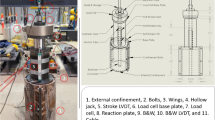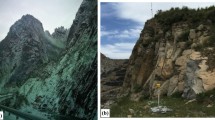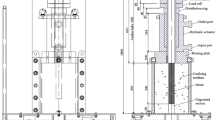Abstract
Cable bolt systems are extensively used to stabilize the roof of underground mining roadways from collapse due to the movement of unstable rock strata. These cable bolts are anchored at both ends and grouted. The inaccessible end of the cable bolt is typically anchored via a resin plug, whereas the exposed end comprises a steel plate with a barrel and wedge. Rock strata movements under gravity or tectonic activities can cause relative separation due to sagging and/or shear sliding of adjacent rock strata and lead to either axial loading or a combination of both axial and shear loading on the cable bolt system. Therefore, this paper presents an experimental study into the large-scale system-level performance of a cable bolt system under simulated relative rock strata movements including vertical separation and shear sliding. The tests were carried out using the Multi-Axis Substructure Testing facility at Swinburne University of Technology, Australia. High-strength reinforced concrete was selected for the confining medium to represent the strong rock strata, while the selected grout was a blended cementitious powder capable of developing high early-age strength and is among the most widely used by the mining industry. The tests were carried out within a 48-h window from grouting to study the influence of the grout medium on the overall system level performance and a non-anchored scenario has also been investigated to provide insight into the potential effects of damaged or unreliable end anchoring.
Access provided by Autonomous University of Puebla. Download conference paper PDF
Similar content being viewed by others
Keywords
1 Introduction
Cable bolt systems are extensively used to stabilize the roof of underground mining roadways from collapse due to the movement of unstable rock strata which typically result from the effects of gravity or tectonic/ground activity. The first use of cable bolts may be traced back to the 1960s when they were used for underground mining in Canada and the mines of South Africa [1,2,3]. Cable bolts are typically inserted into a drilled bore and anchored at both ends and grouted along their length, where the inaccessible end is typically anchored via a resin plug and the exposed end via a steel plate with a barrel and wedge. Unstable rock strata movements tend to comprise of relative separation of strata due to sagging under dead weight and/or sliding of adjacent rock strata under shear. These movements impose either axial or a combination of both axial and shear loading on the cable bolt system as demonstrated in Fig. 1, where Zone 1 represents a stable rock stratum and Zone 2 an unstable stratum above the mining roadway opening. Additionally, cable bolt systems securing highly fractured rock strata can also experience a state of combined axial and shear loading following any relative movement of the fractured rock pieces [4,5,6].
Failure or loss of integrity in a cable bolt system can result due to (1) rupture of the cable bolt, (2) failure of the internal or external anchoring, (3) failure of grout and cable bolt interface causing slippage, (4) failure of grout, (5) failure of grout and confining medium interface causing slippage, (6) failure of the confining medium or (7) a combination of the listed [1, 2, 6,7,8]. The characteristics that influence these failure modes are notably, (1) cable bolt type, (2) encapsulation length, (3) grout characteristics, such as strength, curing time, etc., (4) borehole/shaft diameter, (5) characteristics of the confining me-dium, such as size, strength, etc., (6) cable bolt pre-tensioning, (7) cable bolt restraint condition and (8) confining pressure from surrounding medium [1, 2, 7,8,9,10,11,12,13].
Although cable bolt technologies have advanced considerably, it is reported that a common standard for testing cable bolts in the laboratory is unavailable and various approaches have been adopted which have led to a variety of different results [2, 6, 7, 14,15,16,17]. Moreover, most cable bolt tests comprise short encapsulation setups under either axial or shear loading [2, 7, 13].
Therefore, this paper presents an experimental study into the large-scale system-level performance of a cable bolt system under simulated relative rock strata tensile opening and shear sliding. The tests were carried out using the Multi-Axis Substructure Testing facility at Swinburne University of Technology, in Melbourne, Australia.
2 Methodology
2.1 The Multi-axis Substructure Testing Facility
The multi-axis substructure testing (MAST) facility at Swinburne University of Technology comprises of rigid crosshead supported by four vertical actuators of ±1 MN capacity and two horizontal actuators of ± 500 kN along each of the orthogonal directions. The reaction system comprises a strong wall and floor of 1 m thickness. Figure 2 shows the MAST facility.
The test volume available under the crosshead is about 3 m × 3 m in-plan and 3.2 m in height. The overall system is capable of accurate simulation of complex time-varying 6-DOF boundary effects on large-scale structural components in mixed load/displacement control modes. The system is also robustly designed to carry out hybrid testing, where the flexibility and cost-effectiveness of computer simulation are combined with the realism of experimental testing [18].
2.2 Specimen Selection
The overall aim of this research was to study the system-level performance of a cable bolt system under simulated relative rock strata vertical opening and shear sliding. The test specimen domain is idealized as shown in Fig. 3. The region forming the unstable rock strata is defined as the top embedment or top confining medium and the region concerning the stable rock strata relates to the bottom embedment.
The overall specimen dimensioning was targeted towards enabling, as much as possible, a realistic representation of the field scenario and to work within the limits of the available test space under the MAST facility along with the following considerations, where (1) the size and strength of the embedment was made representative of stiff and/or strong rock mass expecting to have negligible influence on the system level performance, (2) the grout material and grouting approach were kept to the industry standard, yet a focus was to observe system performance at early age between 24–48 h of grouting, (3) the cable bolt encapsulation lengths were selected to enable observations on the cable bolt interaction with the grout medium, which can influence cable bolt slippage prior to rupture, (4) manufacturer specified sizing for the shaft/bore-hole diameter was selected since an industry standard cable bolt was opted for use, (5) the cable bolt bulb distances relative to the joint interface were selected to enable observations on the local effects of the bulb, and (6) allowances were made for flexibility towards changing the anchorage setup to observe the system level effects of anchorage integrity from full anchorage to complete loss of anchorage. General information on the test specimen and key dimensions are presented in Table 1.
2.3 Specimen Preparation
The top and the bottom embedment were cast independently and assembled at the laboratory placing a Teflon sheet at the joint interface to minimize frictional resistance. The cable bolt was then installed and grouted. The grouted specimen was transferred into the test space of the MAST facility and firmly fixed to the crosshead and strong floor before surpassing the pumping life of the grout (~2 h at 20 ºC). The top embedment was fixed to the crosshead as it represents the unstable stratum that will impose movement/loading.
Two string-potentiometers (S-POT) were placed diametrically opposite to each other at a~200 mm distance away from the joint interface over a~400 mm length to monitor the relative axial separation of the joint, where the selected distance was to ensure clearance from any local effects induced by proximity of the cable bolt bulb to the joint. Four S-POTs were placed to monitor the relative axial separation over the full length of the confining medium. That is, two S-POTs were placed on each of the confining mediums to monitor the relative shear sliding at the joint level and in overall, where for the joint level, the S-POTs were~200 mm away from the joint interface. A picture of the overall setup is as shown previously in Fig. 2.
2.4 Test Plan
The first series of tests focused on the relative joint separation or opening mode (+z movement), which reflects stratum movement/sagging under dead weight. The second series of tests reflected relative joint sliding or shear (either + x or + y movement), which reflects lateral movement due to tectonic/ground activity. The considered cable bolt arrangements for both relative joint separation under sagging and sliding comprised of (1) anchored cable bolt only, (2) un-anchored grouted cable bolt and (3) anchored grouted cable bolt.
3 Results and Discussion
3.1 Verification of Material Characteristics
Table 2 shows the 1-day and 28-day compressive strength of the grout and strength of concrete on the day of testing (typically > 28 days) following standard grout cube testing and concrete cylinder tests respectively. The 1-day strength for the grout mix was at 46.0 MPa (expected > 30 MPa) and the 28-Day strength was at 86.9 MPa (expected > 82 MPa). Both values were within manufacturer specifications and confirm consistency in grout preparation. The established concrete strength also confirms the selected mix design for achieving the expected strong rock characteristic.
3.2 Relative Joint Separation in Tension
Figure 4 shows the force-deformation response for the different cases of the cable bolt system under simulated relative joint separation in tension. The anchored un-grouted cable bolt case achieves a max force of~655 kN at~101 mm displacement. As seen from the corresponding curve, the failure mode was the progressive rupture of cable strands due to the concentration of stresses at the anchoring points.
The un-anchored grouted cable bolt case achieves a max force of~735 kN at 245 mm displacement. As seen from the corresponding curve, the overall system lacked stiffness during the initial stages of loading up to~53 mm relative joint displacement, where beyond this point the response was comparable to the anchored cable bolt only case up to~102 mm. Between~102 mm up to~255 mm, the system experienced sustained slippage until the loss of free cable bolt length, which was followed by the gradual reduction in load-carrying capacity due to the gradual loss of skin frictional resistance from being pulled out. The lack of initial stiffness is postulated to be attributed to the fact that the un-anchored cable bolt during installation was un-stretched or slack within the shaft and the stressed grout column near the joint interface was fracturing away due to the close proximity of the bulb as the cable bolt was attempting to straighten. Moreover, the fractured grout column had de-bonded from the concrete confining medium and was seen loosely attached to the cable bolt following sufficient joint separation.
The anchored grouted cable bolt case achieves a max force of~741 kN at~64 mm relative joint displacement. Though the top embedment had no visible signs of cracking, the close proximity of the bulb to the joint interface on the bottom embedment resulted in visible radial cracking of the bottom embedment and a drop in force from~624 kN to~558 kN at~13 mm relative joint displacement. The ultimate failure mode was however a sudden complete cable bolt rupture at the joint interface.
3.3 Relative Joint Sliding in Shear
Figure 5 shows the force-deformation response for the different cases of the cable bolt system under simulated relative joint sliding in shear. For all cases, both the top embedment and the bottom embedment suffered considerable damage, where the bottom suffered the most having not only radial blow-out type cracking but also localized damage at the base of the cylindrical column as a direct result of the large bending moments seen during loading. Additionally, no form of cable failure was observed for the different cases nor was there any discernable slippage for the un-anchored grouted cable bolt case. In fact, after~6 mm of relative joint sliding, the anchored grouted and the un-anchored grouted cable bolt cases seem to have behaved similarly up to~395 kN force, beyond which the anchored case seems to increase in stiffness followed by hardening and the un-anchored case continues unchanged towards the hardening phase. For both the anchored cable bolt only and the anchored grouted cable bolt cases, the hardening portion of the respective curves seems similar, whereas the hardening curve for the un-anchored grouted cable bolt case is much shallower. For an overall purview, the anchored grouted cable bolt case is slightly stiffer than the un-anchored grouted case, and the stiff initial response for both cases is attributed to the presence of the grout column, and potentially the initial contact friction and contact interaction due to bending of the bottom embedment.
4 Conclusions
This paper presented an experimental study on the large-scale testing of a cable system under simulated rock strata separation in tension and sliding in shear. The following conclusions are drawn from this study.
-
1.
For relative joint separation tests in tension
-
The unanchored grouted and anchored grouted cases achieved full cable bolt capacity.
-
The unanchored grouted case seems sensitive to cable bolt orientation and to local bond conditions near fractures/joints which dramatically affect initial stiffness.
-
The unanchored grouted case has the potential to develop comparable stiffness to the cable only scenario if stick-slip conditions prevail along with the bulb effect and also has the added benefit of very large axial movement prior to loss of function.
-
The cable bolt only case suffered premature failure due to stress concentrations at the barrel and wedge anchoring system.
-
The early age characteristics of the grout medium seemed to have had negligible influence on system-level performance, as full cable bolt capacity was reached for both grouted cases.
-
2.
For relative joint sliding tests in shear
-
The unanchored grouted and anchored grouted cases achieved similar performances for the mid-portion of the tests, with the latter having a stiffer initial response.
-
The anchored grouted and anchored cable only cases seemed to have similar strain hardening behaviours towards the latter part of the tests. However, the lack of anchoring for the grouted case may have been leading towards slippage although evidence for such was not visibly discerned due to an embedment failure.
-
All cases suffered considerable damage to the top and bottom embedment despite being massive, stiff and strong. This seems to indicate that heavily fractured strong rock masses could potentially behave as a stiff column assemblage within the influence zone of a cable bolt system, albeit as potentially an inverted cantilever.
-
The size of the embedment seems insufficient to prevent the radial blow-out type cracking of the concrete confining medium, thereby signifying the potential importance of providing confining pressure or lateral stabilisation.
References
Rajaie H (1990) Experimental and Numerical Investigations of Cable Bolt Support Systems. McGill University: Montreal, Canada
Peterson A (2016) Australia. Education, Globalization and the Nation. Palgrave Macmillan UK, London, pp 17–40. https://doi.org/10.1057/9781137460356_3
Komurlu E, Kesimal, A (2016) Rock Bolting from Past to Present in 20 Inventions. Journal of Underground Resources
Windsor CR (1997) Rock Reinforcement Systems. Int J Rock Mech Min Sci 34(6):919–951
Barley AD, Windsor CR (2000) Recent Advancements in Ground Anchor and Ground Reinforcement Technology with Refernce to The Development of The Art, in ISRM International Symposium. Melbourne, Australia
Martin LB (2012) Theoretical and Experimental Study of Fully Grouted Rockbolts and Cablebolts Under Axial Loads. Paris Institute of Technology: France
Li D (2018) Analytical and Laboratory Investigations Into the Failure Mechanisms of Grouted Cable Bolts Subjected to Axial Loading. University of New South Wales: Australia
Li D et al (2019) Experimental and analytical study on the mechanical behaviour of cable bolts subjected to axial loading and constant normal stiffness. Int J Rock Mech Min Sci 113:83–91
Hyett AJ, Bawden WF, Reichert RD (1992) The Effect of Rock Mass Confinement on the Bond Strength of Fully Grouted Cable Bolts. Int J Rock Mech Min Sci Geomech Abstracts 29(5):503–524
Yazic S, Kaiser PK (1992) Bond Strength of Grouted Cable Bolts. Int J Rock Mech Min Sci Geomech Abstracts 29(3):279-292
Hagan P, Chen J, Saydam S (2014) The Load Transfer Mechanism of Fully Grouted Cable Bolts Under Laboratory Tests, in Coal Operators’ Conference. University of Wollongong, Australia
Thompson AG, Villaescusa E (2014) Case Studies of Rock Reinforcement Components and Systems Testing. Rock Mech Rock Eng 47(5):1589–1602. https://doi.org/10.1007/s00603-014-0583-z
Wortley S, Wale JL (2017) Australia. In: Facey KM, Hansen HP, Single ANV (eds) Patient Involvement in Health Technology Assessment. Springer, Singapore, pp 237–242. https://doi.org/10.1007/978-981-10-4068-9_19
Bawden WF, Hyett AJ, Lausch P (1992) An Experimental Procedure for the In Situ Testing of Cable Bolts. Int J Rock Mech Min Sci Geomech Abstracts 29(5):525–533
Thenevin I et al (2017) Laboratory pull-out tests on fully grouted rock bolts and cable bolts: Results and lessons learned. J Rock Mech Geotechn Eng 9(5):843–855
Li D, Masoumi H, Saydam S, Hagan PC (2018) Mechanical characterisation of modified cable bolts under axial loading: an extensive parametric study. Rock Mech Rock Eng 51(9):2895–2910. https://doi.org/10.1007/s00603-018-1475-4
Li D et al (2019) Parametric study of fully grouted cable bolts subjected to axial loading. Can Geotech J 56(10):1514–1525
Al-Mahaidi R et al (2018) Multi-axis Substructure Testing System fro Hybrid Simulation. Springer, Singapore. https://doi.org/10.1007/978-981-10-5867-7
Author information
Authors and Affiliations
Corresponding author
Editor information
Editors and Affiliations
Rights and permissions
Copyright information
© 2023 The Author(s), under exclusive license to Springer Nature Switzerland AG
About this paper
Cite this paper
Srisangeerthanan, S., Hashemi, J., Masoumi, H. (2023). Performance Assessment of Grouted Cable Bolt System Under Rock Strata Movements Using Multi-axis Testing. In: Ilki, A., Çavunt, D., Çavunt, Y.S. (eds) Building for the Future: Durable, Sustainable, Resilient. fib Symposium 2023. Lecture Notes in Civil Engineering, vol 350. Springer, Cham. https://doi.org/10.1007/978-3-031-32511-3_174
Download citation
DOI: https://doi.org/10.1007/978-3-031-32511-3_174
Published:
Publisher Name: Springer, Cham
Print ISBN: 978-3-031-32510-6
Online ISBN: 978-3-031-32511-3
eBook Packages: EngineeringEngineering (R0)









